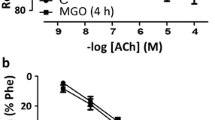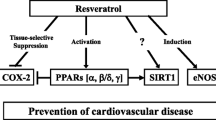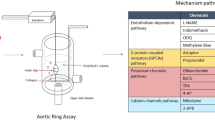Abstract
Purpose
Resveratrol, a polyphenolic compound mainly abundant in red wines, has beneficial cardiovascular effects on various pathological conditions. However, at present, the effect of resveratrol on health promotion remains unclear. Therefore, in this study, we assessed whether long-term resveratrol supplementation changes endothelial function, vascular contractility, nitric oxide and superoxide production in healthy male and female rats.
Methods
Wistar rats were treated with resveratrol (50 mg/l) in their drinking water for 3 weeks. We investigated relaxation to acetylcholine (10−9−10−4 M) and contractions to phenylephrine (10−9−3 × 10−4 M) and angiotensin II (10−10−10−5 M) in either endothelium-intact or denuded aortae from control and resveratrol-treated male and female rats. Aortic superoxide production capacity was measured in response to provocation by angiotensin II and NAD(P)H. Plasma nitrite/nitrate levels and superoxide dismutase (SOD) activity were also evaluated.
Results
Resveratrol supplementation gender independently increased relaxation to acetylcholine and decreased contractions to phenylephrine and angiotensin II in endothelium-intact aortic rings, but not in endothelium-denuded arteries, from healthy male and female rats. This was associated with increased plasma nitrite/nitrate levels. Furthermore, resveratrol caused a refractoriness to angiotensin II and NAD(P)H-induced provocation in superoxide production.
Conclusion
Our results suggest that resveratrol supplementation gender independently could improve the capacity of endothelial function and suppression of oxidative stress under physiological conditions. Resveratrol ingestion indicates a potential for cardiovascular health promotion.







Similar content being viewed by others
References
German JB, Walzem RL. The health benefits of wine. Annu Rev Nutr. 2000;20:561–93.
Sato M, Maulik N, Das DK. Cardioprotection with alcohol: role of both alcohol and polyphenolic antioxidants. Ann New York Acad Sci. 2002;957:122–35.
Chen CK, Pace-Asciak CR. Vasorelaxing activity of resveratrol and quercetin in isolated rat aorta. Gen Pharmacol. 1996;27:363–6.
Orallo F, Alvarez E, Camina M, Leiro JM, Gomez E, Fernandez P. The possible implication of trans-resveratrol in the cardioprotective effects of long-term moderate wine consumption. Mol Pharmacol. 2002;61:294–302.
Rakici O, Kiziltepe U, Coskun B, Aslamacı S, Akar F. Effects of resveratrol on vascular tone and endothelial function of human saphenous vein and internal mammary artery. Int J Cardiol. 2005;105:209–15.
Wallerath T, Deckert G, Ternes T, Anderson H, Li H, Witte K, et al. Resveratrol, a polyphenolic phytoalexin present in red wine, enhances expression and activity of endothelial nitric oxide synthase. Circulation. 2002;106:1652–8.
Bowers JL, Tyulmenkov VV, Jernigan SC, Klinge CM. Resveratrol acts as a mixed agonist/antagonist for estrogen receptors alpha and beta. Endocrinology. 2000;141:3657–67.
Klinge CM, Wickramasinghe NS, Ivanova MM, Dougherty SM. Resveratrol stimulates nitric oxide production by increasing estrogen receptor α-Src-caveolin-1 interaction and phosphorylation in human umbilical vein endothelial cells. FASEB J. 2008;22:2185–97.
Chow S-E, Hshu Y-C, Wang J-S, Chen J-K. Resveratrol attenuates oxLDL-stimulated NADPH oxidase activity and protects endothelial cells from oxidative functional damages. J Appl Physiol. 2007;102:1520–7.
Soylemez S, Gurdal H, Sepici A, Akar F. The effect of long-term resveratrol treatment on relaxation to estrogen in aortae from male and female rats: role of nitric oxide and superoxide. Vasc Pharmacol. 2008;49:97–105.
Zou J-G, Wang Z-R, Huang Y-Z, Cao K-J, Wu JM. Effect of red wine and wine polyphenol resveratrol on endothelial function in hypercholesterolemic rabbits. Int J Mol Med. 2003;11:317–20.
Mizutani K, Ikeda K, Kawai Y, Yamori Y. Resveratrol attenuates ovariectomy-induced hypertension and bone loss in stroke-prone spontaneously hypertensive rats. J Nutr Sci Vitaminol. 2000;46:78–83.
Rush JWE, Quadrilatero J, Levy AS, Ford RJ. Chronic resveratrol enhances endothelium-dependent relaxation but does not alter eNOS levels in aorta of spontaneously hypertensive rats. Exp Biol Med. 2007;232:814–22.
Pearson KJ, Baur JA, Lewis KN, Peshkin L, Price NL, Labinskyy N, et al. Resveratrol delays age-related deterioration and mimics transcriptional aspects of dietary restriction without extending lifespan. Cell Metab. 2008;8:157–68.
Kauser K, Rubanyi GM. Gender difference in bioassayable endothelium-derived nitric oxide from isolated rat aortae. Am J Physiol Heart Circ Physiol. 1994;267:H2311–7.
Nickenig G, Baumer AT, Grohe C, Kahlert S, Strehlow K, Rosenkranz S, et al. Estrogen modulates AT1 receptor gene expression in vitro and in vivo. Circulation. 1998;97:2197–201.
Crews JK, Murphy JG, Khalil RA. Gender differences in Ca2+ entry mechanisms of vasoconstriction in Wistar-Kyoto and spontaneously hypertensive rats. Hypertension. 1999;34:931–6.
Walsh T, Donnelly T, Lyons D. Impaired endothelial nitric oxide bioavailability: a common link between aging, hypertension, and atherogenesis? J Am Geriat Soc. 2009;57:140–5.
Skatchkov MP, Sperling D, Hink U, Mulsch A, Harrison DG, Sindermann I. Validation of lucigenin as a chemiluminescent probe to monitor vascular superoxide as well as basal vascular nitric oxide production. Biochem Biophys Res Commun. 1999;254:319–24.
Coskun B, Soylemez S, Parlar AI, Ulus AT, Katircioglu SF, Akar F. Effect of resveratrol on nitrate tolerance in isolated human internal mammary artery. J Cardiovas Pharmacol. 2006;47:437–45.
Chambliss KL, Shaul PW. Estrogen modulation of endothelial nitric oxide synthase. Endoc Rev. 2002;23:665–86.
Andersen HL, Weis JU, Fjalland B, Korsgaard N. Effect of acute and long-term treatment with 17-β-estradiol on the vasomotor responses in the rat aorta. Br J Pharmacol. 1999;126:159–68.
Gonzales RJ, Walker BR, Kanagy NL. 17β-Estradiol increases nitric oxide-dependent dilation in rat pulmonary arteries and thoracic aorta. Am J Physiol Lung Cell Mol Physiol. 2001;280:L555–64.
Sobey CG, Weiler JM, Boujaoude M, Woodman OL. Effect of short-term phytoestrogen treatment in male rats on nitric oxide-mediated responses of carotid and cerebral arteries: comparison with 17 β-estradiol. J Pharmacol Exp Therap. 2004;310:135–40.
Gehm BD, McAndrews JM, Chien PY, Jameson JL. Resveratrol, a polyphenolic compound found in grapes and wine, is an agonist for the estrogen receptor. Proc Nat Acad Sci USA. 1997;94:14138–43.
Lu R, Serrero G. Resveratrol, a natural product derived from grape, exhibits antiestrogenic activity and inhibits the growth of human breast cancer cells. J Cell Physiol. 1999;179:297–304.
Miyazaki R, Ichiki T, Hashimoto T, Inanaga K, Imayama I, Sadoshima J, et al. SIRT1, a longevity gene, downregulates angiotensin II type 1 receptor expression in vascular smooth muscle cells. Arterioscler Throm Vasc Biol. 2008;28:1263–9.
Aubin M-C, Lajoie C, Clement R, Gosselin H, Calderone A, Perrault LP. Female rats fed a high-fat diet were associated with vascular dysfunction and cardiac fibrosis in the absence of overt obesity and hyperlipidemia: therapeutic potential of resveratrol. J Pharmacol Exp Therap. 2008;325:961–8.
Bradamante S, Barenghi L, Villa A. Cardiovascular protective effects of resveratrol. Cardiovas Drug Rev. 2004;22:169–88.
Mueller CFH, Laude K, McNally JS, Harrison DG. Redox mechanisms in blood vessels. Arterioscler Throm Vasc Biol. 2005;25:274–8.
Guzik TJ, West NE, Black E, McDonald D, Ratnatunga C, Pillai R, et al. Vascular superoxide production by NAD(P)H oxidase: association with endothelial dysfunction and clinical risk factors. Circ Res. 2000;86:85–90.
Didion SP, Faraci FM. Effects of NADH and NADPH on superoxide levels and cerebral vascular tone. Am J Physiol Heart Circ Physiol. 2002;282:H688–95.
Ungvari Z, Orosz Z, Rivera A, Labinskyy N, Xiangmin Z, Olson S, et al. Resveratrol increases vascular oxidative stress resistance. Am J Physiol Heart Circ Physiol. 2007;292:H2417–24.
Griendling KK, FitzGerald GA. Oxidative stress and cardiovascular injury, part II: animal and human studies. Circulation. 2003;108:2034–40.
Baur JA, Sinclair DA. Therapeutic potential of resveratrol: the in vivo evidence. Nat Rev Drug Disc. 2006;5:493–506.
Acknowledgments
This study was supported by a grant from the Gazi University Research Fund (BAP 02/2005-21 and 02/2006-11).
Conflict of interest
The authors state no conflict of interest.
Author information
Authors and Affiliations
Corresponding author
Rights and permissions
About this article
Cite this article
Soylemez, S., Sepici, A. & Akar, F. Resveratrol Supplementation Gender Independently Improves Endothelial Reactivity and Suppresses Superoxide Production in Healthy Rats. Cardiovasc Drugs Ther 23, 449–458 (2009). https://doi.org/10.1007/s10557-009-6198-z
Published:
Issue Date:
DOI: https://doi.org/10.1007/s10557-009-6198-z




